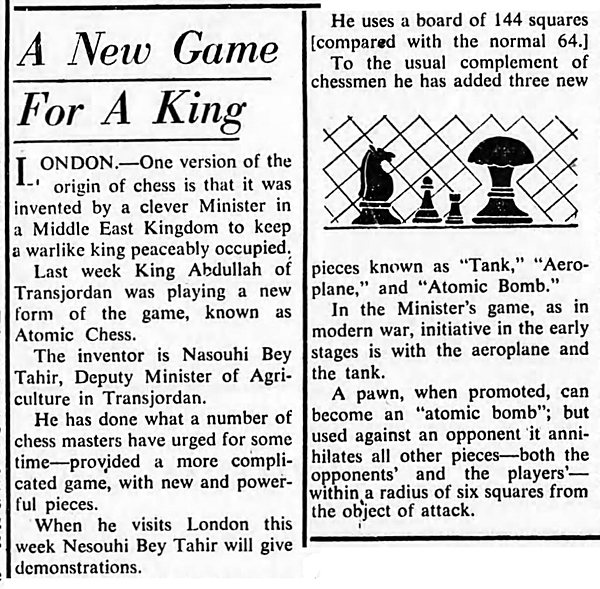Atomic Chess
Atomic Chess is a variant of chess that was invented by Nasouhi Bey Tahir, the Transjordanian Deputy Minister of Agriculture, in 1949. Most of its rules were the same as the traditional game except that it was played on a larger board (of 144 squares) and when a pawn was promoted it would become an 'atomic bomb'. When used it would annihilate all pieces (of both players) within a radius of six squares from the object of attack.
The game also involved two other pieces, a tank and airplane, but I'm not sure how these were used.

Chess.com describes a different version of Atomic Chess, that it says was introduced in 2000. This newer variant is played on a standard board, with the twist that "whenever a piece is captured, an 'explosion' reaching all the squares immediately surrounding the captured piece occurs. This explosion kills all of the pieces in its range except for pawns." Therefore, every capture, except by a pawn, is suicidal.
The game also involved two other pieces, a tank and airplane, but I'm not sure how these were used.

Sydney Morning Herald - May 1, 1949
Chess.com describes a different version of Atomic Chess, that it says was introduced in 2000. This newer variant is played on a standard board, with the twist that "whenever a piece is captured, an 'explosion' reaching all the squares immediately surrounding the captured piece occurs. This explosion kills all of the pieces in its range except for pawns." Therefore, every capture, except by a pawn, is suicidal.
Comments
A few years pre-internet, I joined a loose distributed-coding exercise/experiment to create a game. The idea was everyone worked on an aspect in which they excelled, and then it would all be clobbered together.
It wasn't exactly a chess variant, more just stealing the pieces and some of the rules.
One square was colored. Around that, you arranged your pieces in a 3x3 grid. 12 pawns (3 on each side) went on the outside of that. Pieces moved in standard chess fashion except queens, bishops, and rooks could only move 8 spaces on a turn. (I don't remember there ever being a consensus on pawn movements.) Pawns would be promoted when they landed on an enemy colored space.
It could only be played on a computer: the board was infinite (you could send a piece far out and circle it back to attack from the rear), as was the number of players (each would set up their initial square four spaces away from another player).
Bits and pieces were quickly worked out (I probably learned more about coding from those than from the classes I took), but getting them to work together properly was a major problem, and after a year or so, there was more arguing than coding, so I drifted away from it. After the internet became public, I searched to see what, if anything, ever happened to it but could never find anything.
I still dream of playing a chess game with hundreds of sides and thousands of pieces.
It wasn't exactly a chess variant, more just stealing the pieces and some of the rules.
One square was colored. Around that, you arranged your pieces in a 3x3 grid. 12 pawns (3 on each side) went on the outside of that. Pieces moved in standard chess fashion except queens, bishops, and rooks could only move 8 spaces on a turn. (I don't remember there ever being a consensus on pawn movements.) Pawns would be promoted when they landed on an enemy colored space.
It could only be played on a computer: the board was infinite (you could send a piece far out and circle it back to attack from the rear), as was the number of players (each would set up their initial square four spaces away from another player).
Bits and pieces were quickly worked out (I probably learned more about coding from those than from the classes I took), but getting them to work together properly was a major problem, and after a year or so, there was more arguing than coding, so I drifted away from it. After the internet became public, I searched to see what, if anything, ever happened to it but could never find anything.
I still dream of playing a chess game with hundreds of sides and thousands of pieces.
Posted by Phideaux on 10/22/21 at 01:05 PM
As a lilly-livered Eurotard commie leftie (as some people would call me), I think his message is clear and correct.
As a chess player, this would ruin the game.
(Oh, and @Phideaux: when, pre-internet, would this have been exactly?)
As a chess player, this would ruin the game.
(Oh, and @Phideaux: when, pre-internet, would this have been exactly?)
Posted by Richard Bos on 10/24/21 at 01:32 PM
@Richard Bos -- It had to be between 1977 (when I started using C) and 1983 (when the local college shut down their BBS and we all had to migrate to wobbly Delphi). Probably 1978-1979 based on my remembrance of how poor my coding was.
Posted by Phideaux on 10/25/21 at 05:38 PM
Commenting is not available in this channel entry.

Category: Games | Atomic Power and Other Nuclear Matters | 1940s